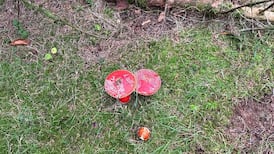Some of the scientific names for creatures have been so easy on the tongue that I would feel sorry to give up saying them, even to myself. Libellula quadrimaculata, for example, was good enough for Linnaeus and a perfect one to show off with. Then it became four-spotted libellula, which at least left me the jingly bit. Now I'm offered four-spotted chaser, which, while a perfectly descriptive vernacular name, offers no music at all, or an allegedly Irish alternative, ruagaire ceathairbhallach, which I would need a month in the Gaeltacht even to go near.
There is, in any case, no other big Irish dragonfly quite like it: gold-brown body, four dark flecks on the wings, poised flatly on the tip of a bog rush or flying up boldly in a papery, crisp-packet rustle of wings.
If the old English folk names – troll flies, horse stingers, devil’s darning needles – ever did find use in Ireland, which I doubt, then the four-spotted chaser might have qualified for its lively but utterly harmless (to people) bouts of aggression and aerial clashes with rivals.
Four-spotted chaser is one of many new common names coined for the 32 species of dragonfly and damselfly so far recorded in Ireland. The process began many decades ago with the remarkable Cynthia Longfield (1896 -1991), daughter of a big-house family in Co Cork who became Madame Dragonfly for her intrepid jungle explorations to study the whirring, glittering family of Odonata.
It has now been refined into scholarly use by two Northerners, Brian Nelson and Robert Thompson, who have been watching dragonflies for 20 years. They were the organisers in 2000 of Dragonfly Ireland, an all-Ireland sightings project based at the Ulster Museum in Belfast and backed by conservation agencies north and south. Amateur and professional naturalists joined in searching bogs and wetlands from the first bright glint of damselflies emerging in spring to the last glimpse of dragonflies scattering their eggs in October.
The survey resulted in a mammoth heavyweight volume, The Natural History of Ireland's Dragonflies, published by the Ulster Museum in 2004. Now this has given wing to a compact updated Guide to the Dragonflies and Damselflies of Ireland (Blackstaff, £25). Again, the first delight is the brilliant macrophotography by Robert Thompson, but Brian Nelson's text is matched also to the artwork of Richard Lewington, a British master of insect illustration.
Among dragonflies the advent of four-spotted chaser, southern hawker, red-veined darter, keeled skimmer and so on has not only opened up the Odonata family to a wider enthusiasm, like that of birdwatching, but also neatly sorted them by their hunting habits.
The hawker patrols a chosen beat, perhaps a stream or canal, to catch midges or mosquitoes in the hairy scoop of its front legs, often munching them on the wing. If the prey is very large it may land to eat it. I once stooped over the common hawker – the male, with brilliant blue spots – finishing off a wasp in the blackcurrant bushes.
Darters offer even better chances of a closer look, as they pick a spot to settle and come back to it again and again between short, rapid dashes after prey. The common darter – golden in the female, brick-red in the male – is widespread in Ireland, missing only from the highest hills, and still on the wing until mid October. The skimmers are the low-flying darters of the windy uplands, and commonest on the hillsides of the west.
What they all share are the wraparound vigilance of great compound eyes and the way the head is mounted to swivel every which way, even underneath and behind: an omnipercipience tensely at odds with the still poise of the body, the shimmering spread of wings.
Climate change has added four new species to the Irish list, notably and wonderfully the big and brilliant emperor dragonfly. (Anax imperator has much the same ring of splendour.) Spreading north and west through Europe, it was confirmed in Ireland in 2000 through sightings by birdwatchers at a lake in Co Wexford. Since then it has spread along south and east coasts from Kerry to Antrim and inland in Armagh, Laois and Monaghan. Recorded sightings now number some 290, with a special concentration in Co Wicklow. (Go to biodiversityireland.ie for distribution maps.)
Almost 8cm, with a wingspan of more than 10cm, the bright-blue and apple-green males (the females are green) are, as Nelson writes in the new guide, “tireless flyers, patrolling at approximately head height, backwards and forwards along a regular beat at the edge of lakes or large ponds”.
They are powerful, domineering creatures that claim big territories as their own. They are still on the wing this month, mostly in the middle of the day, and often show a liking, says Nelson, for well-vegetated and often newly made small bodies of water – so there may even be a chance for Ireland’s larger garden ponds.








